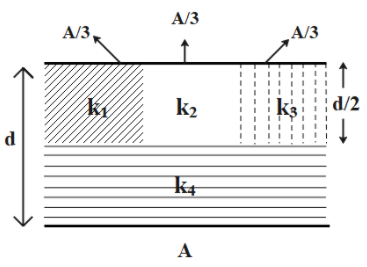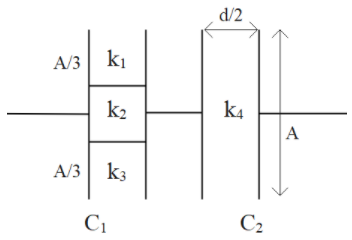
A parallel-plate capacitor of area A, plate separation and capacitance C is filled with four dielectric materials having dielectric constants ${k_1},{k_2},{k_3}{\text{ and }}{k_4}$ as shown in figure below. If a single dielectric material is to be used to have the same capacitance C in this capacitor, then its dielectric constant $k$ is given by

A. $\dfrac{1}{k} = \dfrac{1}{{{k_1}}} + \dfrac{1}{{{k_2}}} + \dfrac{1}{{{k_3}}} + \dfrac{3}{{2{k_4}}}$
B. $k = {k_1} + {k_2} + {k_3} + 3{k_4}$
C. $k = \dfrac{2}{3}\left( {{k_1} + {k_2} + {k_3}} \right) + 2{k_4}$
D. $\dfrac{2}{k} = \dfrac{3}{{{k_1} + {k_2} + {k_3}}} + \dfrac{1}{{{k_4}}}$
Answer
221.4k+ views
Hint: Understand the structure of the given capacitor carefully and then divide it into a combination of its equivalent series or parallel connection of multiple capacitors. Then use the following mentioned formulas to get the required answer.
Formula Used:
Capacitance of a parallel plate capacitor,$C = \dfrac{{{\varepsilon _ \circ }A}}{d}$
Capacitance of a parallel plate capacitor with dielectric, $C = \dfrac{{k{\varepsilon _ \circ }A}}{d}$
In series connection, equivalent capacitance is:
$\dfrac{1}{C} = \dfrac{1}{{{C_1}}} + \dfrac{1}{{{C_2}}}$
In parallel connection, equivalent capacitance is:
$C = {C_1} + {C_2}$
Complete step by step answer:
A capacitor is a setup or arrangement of two conductors separated by an insulating medium that is used to store electric charge and electric energy. A capacitor usually consists of two conductors of any size and shape carrying different potentials and charges, and placed closed together in some definite positions relative to one another.
The capacitance of a capacitor is a constant that may be defined as the charge required to be supplied to either of the conductors of the capacitor so as to increase the potential difference between them by a unit amount. Its SI unit is the farad (F).
For a parallel plate capacitor, its capacitance is given as:
$C = \dfrac{{{\varepsilon _ \circ }A}}{d}$
The capacitance of a parallel capacitor when filled with a dielectric of dielectric constant k,
$C = \dfrac{{k{\varepsilon _ \circ }A}}{d} \cdots \cdots \cdots \cdots \cdots \left( 1 \right)$
Considering the given setup, we can divide it as two capacitors of capacitance ${C_1}{\text{ and }}{C_2}$ in series as shown below:

So the resultant capacitance of this setup will be C, which will be given by:
$\eqalign{
& \dfrac{1}{C} = \dfrac{1}{{{C_1}}} + \dfrac{1}{{{C_2}}} \cr
& \Rightarrow \dfrac{d}{{A{\varepsilon _ \circ }k}} = \dfrac{1}{{{C_1}}} + \dfrac{1}{{{C_2}}} \cr} $
Now, the capacitor ${C_1}$has three capacitors inside it which are in parallel connection with each other. So their total capacitance can be calculated using the direct sum of capacitance of each capacitor.
$\eqalign{
& \Rightarrow \dfrac{d}{{A{\varepsilon _ \circ }k}} = \dfrac{1}{{\dfrac{A}{3}{\varepsilon _ \circ }\dfrac{{\left( {{k_1} + {k_2} + {k_3}} \right)}}{{d/2}}}} + \dfrac{1}{{\dfrac{{A{\varepsilon _ \circ }{k_4}}}{{d/2}}}} \cr
& \Rightarrow \dfrac{d}{k} = \dfrac{{3d}}{{2\left( {{k_1} + {k_2} + {k_3}} \right)}} + \dfrac{d}{{2{k_4}}} \cr
& \therefore \dfrac{2}{k} = \dfrac{3}{{\left( {{k_1} + {k_2} + {k_3}} \right)}} + \dfrac{1}{{{k_4}}} \cr} $
Therefore, the correct option is D. i.e., $\dfrac{2}{k} = \dfrac{3}{{{k_1} + {k_2} + {k_3}}} + \dfrac{1}{{{k_4}}}$
Note: In series connection of capacitors, each capacitor has an equal amount of charge for any value of given capacitance. On the other hand in parallel connection of capacitors, the potential differences of the capacitors connected in parallel are equal for any value of capacitances.
Formula Used:
Capacitance of a parallel plate capacitor,$C = \dfrac{{{\varepsilon _ \circ }A}}{d}$
Capacitance of a parallel plate capacitor with dielectric, $C = \dfrac{{k{\varepsilon _ \circ }A}}{d}$
In series connection, equivalent capacitance is:
$\dfrac{1}{C} = \dfrac{1}{{{C_1}}} + \dfrac{1}{{{C_2}}}$
In parallel connection, equivalent capacitance is:
$C = {C_1} + {C_2}$
Complete step by step answer:
A capacitor is a setup or arrangement of two conductors separated by an insulating medium that is used to store electric charge and electric energy. A capacitor usually consists of two conductors of any size and shape carrying different potentials and charges, and placed closed together in some definite positions relative to one another.
The capacitance of a capacitor is a constant that may be defined as the charge required to be supplied to either of the conductors of the capacitor so as to increase the potential difference between them by a unit amount. Its SI unit is the farad (F).
For a parallel plate capacitor, its capacitance is given as:
$C = \dfrac{{{\varepsilon _ \circ }A}}{d}$
The capacitance of a parallel capacitor when filled with a dielectric of dielectric constant k,
$C = \dfrac{{k{\varepsilon _ \circ }A}}{d} \cdots \cdots \cdots \cdots \cdots \left( 1 \right)$
Considering the given setup, we can divide it as two capacitors of capacitance ${C_1}{\text{ and }}{C_2}$ in series as shown below:

So the resultant capacitance of this setup will be C, which will be given by:
$\eqalign{
& \dfrac{1}{C} = \dfrac{1}{{{C_1}}} + \dfrac{1}{{{C_2}}} \cr
& \Rightarrow \dfrac{d}{{A{\varepsilon _ \circ }k}} = \dfrac{1}{{{C_1}}} + \dfrac{1}{{{C_2}}} \cr} $
Now, the capacitor ${C_1}$has three capacitors inside it which are in parallel connection with each other. So their total capacitance can be calculated using the direct sum of capacitance of each capacitor.
$\eqalign{
& \Rightarrow \dfrac{d}{{A{\varepsilon _ \circ }k}} = \dfrac{1}{{\dfrac{A}{3}{\varepsilon _ \circ }\dfrac{{\left( {{k_1} + {k_2} + {k_3}} \right)}}{{d/2}}}} + \dfrac{1}{{\dfrac{{A{\varepsilon _ \circ }{k_4}}}{{d/2}}}} \cr
& \Rightarrow \dfrac{d}{k} = \dfrac{{3d}}{{2\left( {{k_1} + {k_2} + {k_3}} \right)}} + \dfrac{d}{{2{k_4}}} \cr
& \therefore \dfrac{2}{k} = \dfrac{3}{{\left( {{k_1} + {k_2} + {k_3}} \right)}} + \dfrac{1}{{{k_4}}} \cr} $
Therefore, the correct option is D. i.e., $\dfrac{2}{k} = \dfrac{3}{{{k_1} + {k_2} + {k_3}}} + \dfrac{1}{{{k_4}}}$
Note: In series connection of capacitors, each capacitor has an equal amount of charge for any value of given capacitance. On the other hand in parallel connection of capacitors, the potential differences of the capacitors connected in parallel are equal for any value of capacitances.
Recently Updated Pages
[Awaiting input: Please provide the content from "Ask AI Response," "Competitor 1," and "Competitor 2," so I can perform the analysis and synthesize the requested metadata and headings.]

Young’s Double Slit Experiment Derivation Explained

A square frame of side 10 cm and a long straight wire class 12 physics JEE_Main

The work done in slowly moving an electron of charge class 12 physics JEE_Main

Two identical charged spheres suspended from a common class 12 physics JEE_Main

According to Bohrs theory the timeaveraged magnetic class 12 physics JEE_Main

Trending doubts
JEE Main 2026: Application Form Open, Exam Dates, Syllabus, Eligibility & Question Papers

Derivation of Equation of Trajectory Explained for Students

Hybridisation in Chemistry – Concept, Types & Applications

Understanding the Angle of Deviation in a Prism

How to Convert a Galvanometer into an Ammeter or Voltmeter

Degree of Dissociation: Meaning, Formula, Calculation & Uses

Other Pages
JEE Advanced Marks vs Ranks 2025: Understanding Category-wise Qualifying Marks and Previous Year Cut-offs

Dual Nature of Radiation and Matter Class 12 Physics Chapter 11 CBSE Notes - 2025-26

Ideal and Non-Ideal Solutions Explained for Class 12 Chemistry

Understanding the Electric Field of a Uniformly Charged Ring

Understanding Atomic Structure for Beginners

Understanding Electromagnetic Waves and Their Importance




